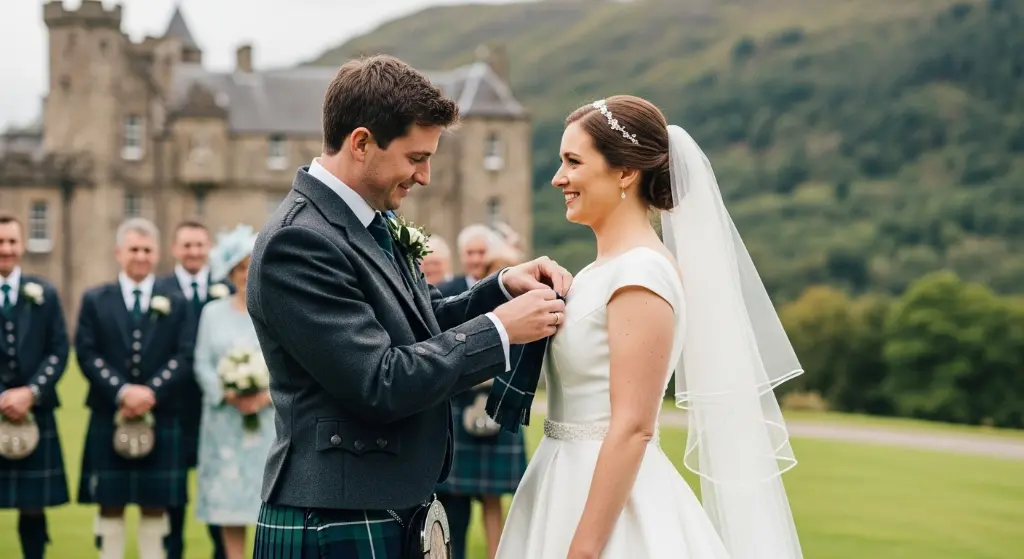Discover the rich history of the traditional Welsh costume. Learn about the iconic tall hat, the cozy flannel shawl, and how this distinctive dress became a powerful symbol of Welsh national identity.
The Enduring Charm of Traditional Welsh Costume
Picture a postcard from Wales. You might see rolling green hills, ancient castles, and perhaps a woman dressed in a striking and distinctive outfit: a long, full skirt, a warm shawl, and, most famously, a tall, black “chimney” hat perched atop a frilly white cap. This is the traditional Welsh costume, an image that has become synonymous with Welsh identity and heritage.
But is this famous outfit a true reflection of what Welsh women wore for centuries, or is it a more modern invention?
The story of the Welsh costume is a fascinating journey through rural life, industrial change, and the powerful rise of national consciousness in the 19th century. It is a tale of how a practical, everyday dress was transformed into a national symbol.
See also Traditional Clothing in Japan
Traditional Clothing in Japan
In this article, we will explore:
✅ The historical origins and components of the traditional Welsh dress.
✅ The mystery and symbolism of the iconic Welsh hat.
✅ How this costume became a powerful emblem of Welsh identity.
✅ Its role today, from school celebrations on St. David’s Day to international folk festivals.
Prepare to unravel the threads of history woven into this beloved and iconic attire.
📜 The Historical Reality: The Dress of Rural Wales
Before it became a “costume,” the outfit we now recognize was the everyday working dress of rural women in Wales during the late 18th and early 19th centuries. It was not a uniform; styles, fabrics, and colors varied significantly from region to region. However, it generally consisted of several practical and durable layers.
The Core Components:
See also Traditional Japanese Clothing: Yukata
Traditional Japanese Clothing: Yukata
- The Gown (Beti): The main garment was a long, open-fronted gown, similar to an English bedgown. It was typically made of sturdy, locally woven wool flannel, often in simple stripes or checks. The colors were derived from natural dyes, resulting in shades of red, brown, grey, and blue.
- The Skirt (Pais): A full, heavy skirt, also made of wool, was worn underneath the gown. It was designed for warmth and durability.
- The Apron (Ffedog): A large apron, usually made of checked wool or linen, was worn over the skirt. It was a practical item, protecting the skirt from dirt during daily chores, but it also became a decorative element.
- The Shawl (Siôl): This was perhaps the most versatile and cherished part of the outfit. A large, square or rectangular shawl, often made of fine wool, was draped over the shoulders for warmth. The most famous were the beautiful, intricate Paisley pattern shawls, which were imported and a sign of some prosperity. In colder weather, a simple, warm, home-spun flannel shawl was worn.
- The Cap (Capan): Underneath the hat, women wore a close-fitting white cotton or linen cap, often with frilled lace edges that framed the face. This was a common item of headwear for married women across Britain at the time, worn for modesty and cleanliness.
- Stockings and Shoes: Hand-knitted wool stockings and sturdy, black leather shoes completed the practical ensemble.
The “traditional costume” began as the practical, regional working dress of Welsh countrywomen. Its primary purpose was warmth, durability, and modesty.
🎩 The Welsh Hat: An Icon of Mystery and Debate
No element of the Welsh costume is more famous or more debated than the tall, black Welsh hat (Het Gymreig).
Description:
The classic Welsh hat is a tall, rigid, chimney-pot-shaped hat made of black silk plush or felt, with a wide, stiff brim. It is strikingly different from any other folk hat in Britain.
The Origins and The Mystery:
The precise origin of this unique hat is a subject of much historical debate. It did not appear until the 1830s and became popular in the 1840s and 50s. There are several theories:
- A link to the “stovepipe” hat: Some historians believe it evolved from the tall top hats worn by men in the Regency period, adapted for women.
- A “national” invention: Others suggest it was a style consciously promoted by certain figures to create a distinctive “Welsh” look, differentiating it from English fashions.
- A regional fashion: It was most popular in the rural areas of northwest Wales. In other parts of Wales, women wore different styles, such as a more rounded, “cockle-hat” style, or simply their lace cap.
Regardless of its origin, by the mid-19th century, the tall Welsh hat had become the defining feature of the national costume. It was a formal, “Sunday best” item, not something worn for everyday chores. It was a sign of respectability and status.
🛡️ From Everyday Dress to National Symbol: The Role of Lady Llanover

So, how did this rural working dress become a standardized “national costume”? A key figure in this transformation was Augusta Hall, Lady Llanover (1802-1896).
Lady Llanover was an influential and passionate advocate for Welsh culture. At a time when Welsh language, music, and traditions were under threat from English influence, she worked tirelessly to promote and preserve them.
- Promoting a National Dress: Lady Llanover believed that a distinctive national dress was essential for a strong national identity. She encouraged the wearing of Welsh flannel and the tall hat at cultural events, particularly at the eisteddfodau (Welsh festivals of literature, music, and performance).
- Creating an “Ideal”: While she based her ideas on existing rural dress, she romanticized and standardized it. She promoted a specific version of the costume—often featuring bold stripes—as the “correct” national dress.
- The Power of Print: In the mid-19th century, the rise of tourism brought many English visitors to Wales. They were enchanted by the “quaint” and “picturesque” sight of Welsh women in their traditional dress. Illustrations and postcards featuring women in the costume, especially with the dramatic tall hat, became incredibly popular. These images spread across Britain and helped to cement this specific look as the traditional Welsh costume in the public imagination.
The Transformation: What began as a genuine, varied folk dress was consciously and unconsciously molded into a single, iconic national symbol, partly as a response to external pressures and partly as a proud assertion of Welsh identity.
🌼 The Costume Today: A Celebration of Welshness
Today, the traditional Welsh costume is no longer worn as daily attire. However, it holds a cherished and important place in modern Welsh culture.
- St. David’s Day (Dydd Gŵyl Dewi): On March 1st, Wales’s national day, schools across the country celebrate Welsh culture. It is a common and beloved tradition for young girls to dress up in a version of the traditional costume. This is often their first and most memorable connection to this piece of their heritage.
- Folk Festivals and Eisteddfodau: Members of folk dance groups, choirs, and performers at cultural festivals wear the costume to represent their nation. It is a uniform of cultural ambassadorship.
- A Symbol of “Welshness”: The image of the Welsh lady in her hat and shawl is used extensively in tourism marketing, on souvenirs, and in branding to instantly signify “Wales.” It is a powerful and easily recognizable symbol of the country.
- Modern Interpretations: Some modern Welsh designers and artists draw inspiration from the costume, reinterpreting the patterns of the flannel, the shape of the hat, or the drape of the shawl in contemporary fashion, keeping the tradition alive in new and creative ways.
Conclusion: A Woven Identity
The traditional Welsh costume is a beautiful example of how clothing can evolve from a practical necessity into a powerful national symbol. It tells a story of a rural past, of hard-working women, and of a nation determined to preserve its unique identity in the face of change.
The tall black hat, once perhaps just a fleeting fashion, has become an enduring crown of Welshness. The warm flannel shawl, once a shield against the wind and rain, now wraps the nation in a comforting embrace of shared heritage.
So, the next time you see that iconic image, you will see more than just a quaint costume. You will see a story of resilience, pride, and the enduring spirit of Wales, woven in wool and silk.
